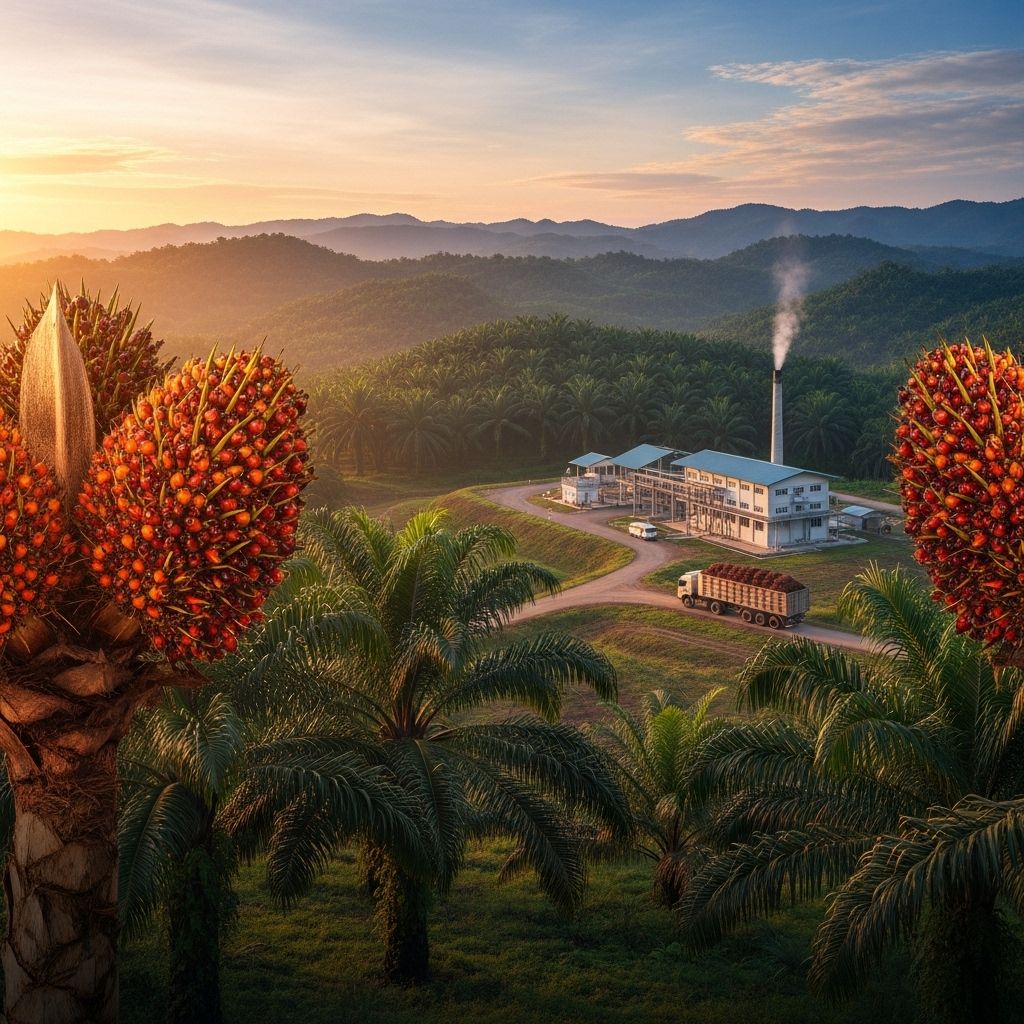How Palm Oil Is Made: Production, Impacts, and Sustainability
Unveiling the journey of palm oil from plantation to product and the environmental realities behind its global rise.

How Palm Oil Is Made: From Plantation to Product
Palm oil is the world’s most widely consumed vegetable oil, found in everything from food products to cosmetics and household goods. Its versatile properties and high yield have driven a vast expansion of palm oil plantations across tropical regions, notably in Southeast Asia. However, this rapid growth has significant social and environmental consequences, stirring global conversations about sustainability, conservation, and responsible consumption.
What Is Palm Oil?
Palm oil is extracted from the fruit of the oil palm tree, primarily Elaeis guineensis. The fruit’s flesh yields crude palm oil, while the kernel produces palm kernel oil—each serving distinct industrial purposes. Due to its neutral flavor, high heat stability, and creamy texture, palm oil is favored in processed foods, cooking oil, soaps, and personal care products.
- Palm oil is present in more than half of supermarket products.
- Indonesia and Malaysia produce over 85% of the world’s palm oil supply.
- Palm oil trees thrive in tropical climates with consistent rainfall and warmth.
The Palm Oil Production Process
Production begins with large monoculture plantations where oil palms are cultivated for about 25 years after planting. Here’s a step-by-step overview:
- Planting: Oil palm seedlings are grown and transplanted into plantations, typically on cleared forest or peatland.
- Growth & Harvest: Trees mature within 3–4 years, producing bunches of fruit that ripen year-round, yielding up to 40 kilograms per bunch.
- Collection: Workers harvest ripe fruit by hand using sickles or mechanical tools.
- Processing:
- Fruit is separated from bunches and sterilized with steam to prevent enzymatic spoilage.
- Oil is extracted by mechanical pressing, then clarified and purified.
- Palm kernel oil is pressed from the kernel itself, using analogous processes.
- Refining & Distribution: Crude palm oil is refined, bleached, and deodorized for diverse end uses.
| Stage | Description |
|---|---|
| Planting | Seeds cultivated in nurseries and transplanted to plantation fields |
| Harvesting | Year-round manual or mechanical harvest of fruit bunches |
| Processing | Fruit sterilized, oil extracted and refined |
| Distribution | Oil packaged, shipped for food, cosmetics, or industrial uses |
Environmental Impacts of Palm Oil Production
Palm oil’s popularity comes at a steep ecological price, particularly in Indonesia and Malaysia. Key issues include:
Deforestation
Large areas of tropical rainforest have been cleared for new plantations. This deforestation:
- Destroys critical habitats for endangered species, including orangutans, Sumatran rhinos, and tigers.
- Contributes significantly to global forest loss, though estimates of palm oil’s direct contribution vary between 2% and 4% of annual global greenhouse gas emissions.
- Induces soil degradation and changes water cycles, impacting broader ecosystem services.
Greenhouse Gas Emissions
Palm oil plantations are frequently established on peatlands, which are highly effective carbon sinks. The conversion of peatland to plantations:
- Releases vast amounts of stored carbon, exacerbating climate change.
- In Indonesia alone, annual average emissions from palm oil production reached 220 million tonnes of CO2 equivalent between 2015 and 2022, nearly one-fifth of the country’s total emissions.
- Fires set for land clearing cause periodic air pollution events known as haze, affecting millions across Southeast Asia.
Biodiversity Loss
The destruction of intact forest landscapes puts many species at risk of extinction and causes human-wildlife conflict as animals leave degraded habitats:
- Sumatran and Bornean orangutans are critically endangered, with vast tracts of habitat lost to plantations.
- Forest fragmentation isolates wildlife populations, reducing genetic diversity as animals are forced to traverse dangerous plantation landscapes.
Social Impacts: Communities & Labor
Palm oil production provides livelihoods to millions, but these benefits are offset by serious social challenges:
- Many indigenous communities lose land and resources, leading to displacement and impoverishment.
- Labor rights abuses, including poor working conditions and child labor, remain rampant in some regions.
- Local populations suffer from degraded environment and health issues due to water pollution, reduced air quality, and diminished food resources.
Palm Oil and Sustainable Alternatives
Given palm oil’s high yields and economic benefits, eliminating the crop is not a straightforward solution. Instead, sustainable production and responsible sourcing have emerged as key strategies:
Certification Systems
- RSPO (Roundtable on Sustainable Palm Oil): Offers certification to producers meeting criteria for responsible land use, no deforestation, fair labor, and community rights.
- Certified sustainable palm oil reduces negative environmental impacts and prohibits new plantations on peat.
Zero-Deforestation Pledges
- Major importers—US, EU, UK—have increasingly sourced palm oil from companies with zero-deforestation commitments. In Indonesia, 98% of palm oil exports to these regions come from such companies.
- However, these markets only account for 9% of Indonesian palm oil production, while less regulated markets still support unsustainable practices.
Conservation Efforts & Ecological Solutions
- Environmental organizations advocate for protected primary forests and conservation corridors to preserve biodiversity.
- New approaches involve direct collaboration between conservationists and companies to set aside lands for nature reserves funded by plantation profits.
- Agroforestry models and mixed-crop plantations have promise for reducing monoculture impacts.
Should Consumers Avoid Palm Oil?
The question of whether individuals should boycott palm oil is complicated. Palm oil is more land-efficient than other vegetable oils, requiring far less acreage to produce equivalent yields. Some experts warn that switching to alternatives such as soybean oil or rapeseed could mean even greater land conversion and environmental harm.
- The key is not simply to avoid palm oil, but to demand products made with certified sustainable or responsibly sourced palm oil.
- Consumers have power to support companies with clear sustainability commitments and transparent supply chains.
Palm Oil Production: Global Data and Trends
| Country | Annual Production (million tonnes) | Major Environmental Concerns |
|---|---|---|
| Indonesia | 45 | Deforestation, peat emissions, biodiversity loss |
| Malaysia | 19 | Habitat fragmentation, peat drainage, haze |
| Thailand, Nigeria, Colombia | 1-2 | Smallholder economics, rainforest conversion |
Frequently Asked Questions (FAQs)
Q: Is palm oil always bad for the environment?
A: No. While most conventional palm oil is linked to deforestation and habitat loss, certified sustainable palm oil offers a lower-impact alternative by ensuring responsible land use and habitat protection.
Q: Why don’t we just switch to other vegetable oils?
A: Palm oil’s yield per acre is significantly higher than alternatives like soybean or sunflower oil. Switching could lead to greater deforestation elsewhere. Efforts focus on making current production more sustainable.
Q: Does palm oil farming impact indigenous communities?
A: Yes. Expansion of plantations has displaced indigenous peoples and affected their access to land, food, and livelihoods. Certification systems and sustainable pledges are being promoted to protect community rights.
Q: What are peatlands, and why are they important in palm oil production?
A: Peatlands are wetland ecosystems rich in stored carbon. Draining and converting peatlands for agriculture releases greenhouse gases, contributing to climate change.
Q: Can palm oil plantations support wildlife?
A: Conventional monoculture plantations generally offer little to no habitat for wildlife. Some efforts focus on conservation corridors and mixed agroforestry models to improve outcomes.
What You Can Do: Supporting Sustainable Palm Oil
- Look for RSPO or other certification labels on products containing palm oil.
- Support brands and retailers with transparent sourcing and zero-deforestation policies.
- Stay informed about companies’ environmental track records and choose those investing in biodiversity conservation.
- Advocate for stronger environmental and community protections within import legislation.
Conclusion: The Future of Palm Oil
Palm oil remains a staple of global agriculture and commerce, yet its production raises complex environmental and social concerns. Transforming the sector requires cooperation among governments, corporations, local communities, and consumers. With improved transparency, robust certification, and conservation-minded regulations, it is possible to balance economic returns with the protection of people and planet. The journey from plantation to product reflects not only industry innovation but also the urgent need for sustainable practices that benefit future generations.
References
- https://en.wikipedia.org/wiki/Social_and_environmental_impact_of_palm_oil
- https://www.sei.org/features/indonesian-palm-oil-exports-and-deforestation/
- https://earth.org/the-challenges-of-sustainable-palm-oil-production-and-consumption/
- https://ourworldindata.org/palm-oil
- https://rspo.org/why-sustainable-palm-oil/environmental-impact/
- https://www.europarl.europa.eu/RegData/etudes/ATAG/2020/659335/EPRS_ATA(2020)659335_EN.pdf
- https://www.nature.com/articles/s41477-020-00813-w
- https://www.wwf.org.uk/updates/8-things-know-about-palm-oil
Read full bio of medha deb












